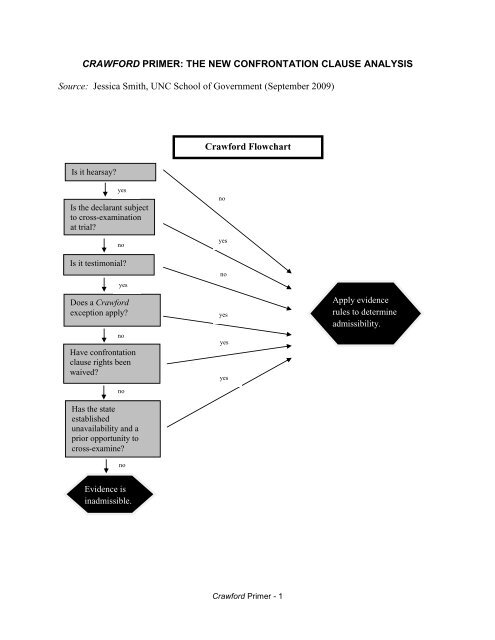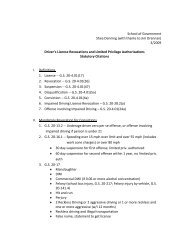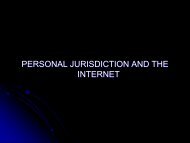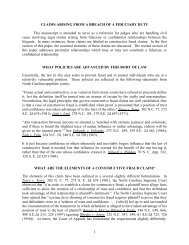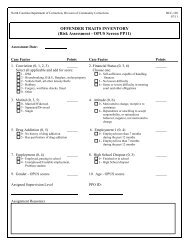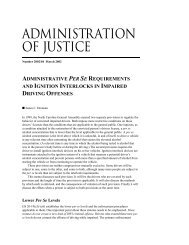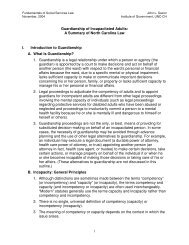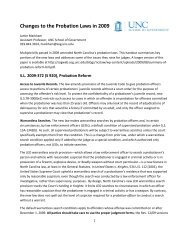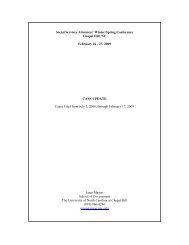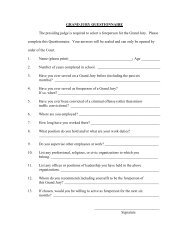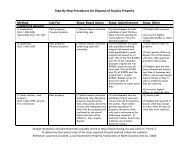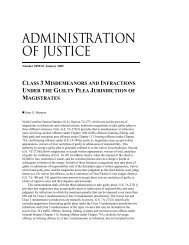Crawford - School of Government
Crawford - School of Government
Crawford - School of Government
You also want an ePaper? Increase the reach of your titles
YUMPU automatically turns print PDFs into web optimized ePapers that Google loves.
CRAWFORD PRIMER: THE NEW CONFRONTATION CLAUSE ANALYSIS<br />
Source: Jessica Smith, UNC <strong>School</strong> <strong>of</strong> <strong>Government</strong> (September 2009)<br />
<strong>Crawford</strong> Flowchart<br />
Is it hearsay?<br />
yes<br />
Is the declarant subject<br />
to cross-examination<br />
at trial?<br />
no<br />
Is it testimonial?<br />
yes<br />
Does a <strong>Crawford</strong><br />
exception apply?<br />
no<br />
Have confrontation<br />
clause rights been<br />
waived?<br />
no<br />
Has the state<br />
established<br />
unavailability and a<br />
prior opportunity to<br />
cross-examine?<br />
no<br />
no<br />
yes<br />
no<br />
yes<br />
yes<br />
yes<br />
Apply evidence<br />
rules to determine<br />
admissibility.<br />
Evidence is<br />
inadmissible.<br />
<strong>Crawford</strong> Primer - 1
For more detailed information regarding all <strong>of</strong> the topics covered in this outline, see the<br />
following online publications:<br />
<strong>Crawford</strong> v. Washington: Confrontation One Year Later, available online at:<br />
http://shopping.netsuite.com/s.nl/c.433425/it.A/id.79/.f<br />
Emerging Issues in Confrontation Litigation: A Supplement to <strong>Crawford</strong> v. Washington:<br />
Confrontation One Year Later, available online at:<br />
http://shopping.netsuite.com/s.nl/c.433425/it.A/id.973/.f<br />
Evidence Issues in Criminal Cases Involving Child Victims and Child Witnesses, pp. 14-<br />
34, available online at: http://shopping.netsuite.com/s.nl/c.433425/it.I/id.369/.f<br />
Melendez-Diaz & the Admissibility <strong>of</strong> Forensic Laboratory Reports &<br />
Chemical Analyst Affidavits in North Carolina Post-<strong>Crawford</strong>, available online at:<br />
http://www.sog.unc.edu/programs/crimlaw/faculty.htm<br />
The North Carolina General Assembly’s Response to Melendez-Diaz, available online at:<br />
http://www.sog.unc.edu/programs/crimlaw/faculty.htm<br />
I. Introduction<br />
A. A new analysis. The United States Supreme Court's decision in <strong>Crawford</strong> v. Washington,<br />
541 U.S. 36 (2004), radically revamped confrontation clause analysis. <strong>Crawford</strong><br />
overruled the Ohio v. Roberts, 448 U.S. 56 (1980), reliability test for confrontation clause<br />
analysis and set in place a new, stricter standard for admission <strong>of</strong> hearsay statements<br />
under the confrontation clause.<br />
B. When <strong>Crawford</strong> issues arise. The new <strong>Crawford</strong> rule potentially comes into play<br />
whenever the state seeks to introduce hearsay statements <strong>of</strong> a witness who is not subject<br />
to cross-examination at the defendant’s criminal trial.<br />
C. Relationship to hearsay rules. Under the old Roberts test, confrontation clause analysis<br />
collapsed into hearsay analysis. <strong>Crawford</strong> rejected this approach, creating a separate<br />
standard for admission under the confrontation clause. However, <strong>Crawford</strong> did not affect<br />
the hearsay rules. Thus, after <strong>Crawford</strong>, the state has two hurdles to leap before hearsay<br />
statements by nontestifying witnesses may be admitted at trial: (1) the new <strong>Crawford</strong> rule<br />
and (2) the hearsay rules.<br />
II. The <strong>Crawford</strong> rule. At issue in <strong>Crawford</strong> was whether the trial court’s admission <strong>of</strong> a<br />
statement made by a suspect during a police interrogation violated the defendant’s<br />
confrontation clause rights. The Court held that it did and articulated what has come to be<br />
known as the <strong>Crawford</strong> rule: Testimonial statements by witnesses who are not subject to<br />
cross-examination at trial may not be admitted unless the witness is unavailable and there has<br />
been a prior opportunity for cross-examination.<br />
The <strong>Crawford</strong> Rule:<br />
Testimonial statements by witnesses who are not subject to crossexamination<br />
at trial may not be admitted unless the witness is unavailable<br />
and there has been a prior opportunity for cross-examination.<br />
<strong>Crawford</strong> Primer - 2
A. Meaning <strong>of</strong> the term “testimonial”<br />
1. No comprehensive definition. The <strong>Crawford</strong> Court declined to comprehensively<br />
define the term testimonial. Instead, it gave a few examples <strong>of</strong> nontestimonial<br />
statements (<strong>of</strong>fhand remarks, casual remarks to acquaintances, business records, and<br />
statements in furtherance <strong>of</strong> the conspiracy) and a few examples <strong>of</strong> testimonial<br />
statements (prior testimony, plea allocutions, and police interrogations; <strong>Crawford</strong><br />
itself involved statements made during a police interrogation). Having categorized<br />
these few types <strong>of</strong> evidence, the Court left to the lower courts the difficult task <strong>of</strong><br />
categorizing the many other types <strong>of</strong> evidence <strong>of</strong>fered in criminal trials.<br />
a. Davis v. Washington. The lack <strong>of</strong> a comprehensive definition <strong>of</strong> the key term<br />
“testimonial” resulted in significant litigation in the lower courts. It did not take<br />
long for additional cases to reach the high Court or for the Court to agree to hear<br />
them. In 2006, the Court issued a decision in Davis v. Washington, 547 U.S. 813<br />
(2006), which was a consolidation <strong>of</strong> two separate domestic violence cases, both<br />
raising questions about the testimonial nature <strong>of</strong> statements by victims to police<br />
<strong>of</strong>ficers and their agents. Davis articulated a two-part rule for determining the<br />
testimonial nature <strong>of</strong> statements to the police or their agents: (a) Statements are<br />
nontestimonial when made in the course <strong>of</strong> police interrogation under<br />
circumstances objectively indicating that the primary purpose <strong>of</strong> the interrogation<br />
is to enable police assistance to meet an ongoing emergency; and (b) Statements<br />
are testimonial when the circumstances objectively indicate that there is no such<br />
ongoing emergency, and that the primary purpose <strong>of</strong> the interrogation is to<br />
establish or prove past facts potentially relevant to later criminal prosecution.<br />
The Davis Rules:<br />
Statements are nontestimonial when made in the course <strong>of</strong> police<br />
interrogation under circumstances objectively indicating that the primary<br />
purpose <strong>of</strong> the interrogation is to enable police assistance to meet an<br />
ongoing emergency.<br />
Statements are testimonial when the circumstances objectively indicate<br />
that there is no such ongoing emergency, and that the primary purpose <strong>of</strong><br />
the interrogation is to establish or prove past facts potentially relevant to<br />
later criminal prosecution.<br />
2. Some open questions regarding the testimonial/nontestimonial distinction<br />
a. Does <strong>Crawford</strong> apply outside <strong>of</strong> the context <strong>of</strong> police interrogation? Both<br />
<strong>Crawford</strong> and Davis involved police questioning—in <strong>Crawford</strong> the questioning<br />
was <strong>of</strong> a suspect at a station house after Miranda warnings had been given; in<br />
Davis the questioning was <strong>of</strong> domestic violence victims at the scene. Thus, one<br />
open question is how and if <strong>Crawford</strong> applies to statements made to people other<br />
than the police or their agents, such as family members, social workers, and<br />
medical pr<strong>of</strong>essionals.<br />
<strong>Crawford</strong> Primer - 3
i. Statements to family, friends, and other private persons. While many<br />
cases seem to adopt a per se rule that statements to family, friends, and other<br />
private persons are nontestimonial, some cases have applied the Davis<br />
primary purpose test to these statements.<br />
ii. Statements to medical personnel. The vast majority <strong>of</strong> cases apply the Davis<br />
primary purpose test to statements made to medical personnel, such as<br />
emergency room doctors and SANE nurses.<br />
iii. Statements to social workers. The testimonial nature <strong>of</strong> statements by child<br />
victims to social workers is a hotly litigated area <strong>of</strong> confrontation clause<br />
analysis. For a detailed discussion <strong>of</strong> this issue, see the child evidence<br />
publication noted at the beginning <strong>of</strong> this outline.<br />
b. Who is a police agent? <strong>Crawford</strong> clearly applies whenever questioning is done<br />
by the police or a police agent (in Davis, the Court assumed but did not decide<br />
that a 911 operator was a police agent). Factors that post-Davis decisions have<br />
cited when determining that actors were agents <strong>of</strong> the police include the<br />
following:<br />
The police directed the victim to the interviewer or requested or arranged for<br />
the interview<br />
The interview was forensic<br />
A law enforcement <strong>of</strong>ficer was present during the interview<br />
A law enforcement <strong>of</strong>ficer observed the interview from another room<br />
A law enforcement <strong>of</strong>ficer videotaped the interview<br />
The interviewer consulted with a prosecution investigator before or during the<br />
interview<br />
The interviewer consulted with a law enforcement <strong>of</strong>ficer before or during the<br />
interview<br />
The interviewer asked questions at the behest <strong>of</strong> a law enforcement <strong>of</strong>ficer<br />
The purpose <strong>of</strong> the interview was to further a criminal investigation<br />
The lack <strong>of</strong> a non-law enforcement purpose to the interview<br />
The fact that law enforcement was provided with a videotape <strong>of</strong> the interview<br />
after it concluded<br />
c. What is an emergency? Another open question is: what constitutes an ongoing<br />
emergency and when does it end? The case law in this area is still evolving.<br />
i. Ongoing emergency. The following factors support the conclusion that an<br />
emergency was ongoing:<br />
The perpetrator remains at the scene and is not in law enforcement custody<br />
The perpetrator is at large and presents a present or continuing threat<br />
Physical violence is occurring<br />
The location is disorderly<br />
The location is unsecure<br />
Medical attention is needed or the need for it is not determined<br />
The victim or others are in danger<br />
The questioning occurs close in time to the event<br />
The victim or others call for assistance<br />
<strong>Crawford</strong> Primer - 4
The victim or others are agitated<br />
No <strong>of</strong>ficers are at the scene<br />
ii. No ongoing emergency. The following factors support the conclusion that an<br />
emergency ended or did not exist:<br />
The perpetrator has fled and is unlikely to return<br />
The perpetrator is in law enforcement custody<br />
No physical violence is occurring<br />
The location is calm<br />
The location is secure<br />
No medical attention is needed<br />
The victim and others are safe<br />
There is a significant lapse <strong>of</strong> time between the event and the questioning<br />
No call for assistance is made<br />
The victim or others are calm<br />
Officers are at the scene<br />
d. What is the primary purpose <strong>of</strong> the interrogation? Davis requires the decisionmaker<br />
to determine the primary purpose <strong>of</strong> the interrogation. It is not clear how<br />
the statements will be categorized if the primary purpose <strong>of</strong> the interrogation was<br />
something other than meeting an ongoing emergency or establishing past facts, or<br />
if there was a dual, evenly weighted purpose for the interrogation.<br />
e. How does <strong>Crawford</strong> apply to reports and affidavits? There has been a<br />
significant amount <strong>of</strong> post-<strong>Crawford</strong> litigation over whether various reports and<br />
affidavits are testimonial or not, particularly with regard chemical analysts’<br />
reports in impaired driving cases, blood tests, lab reports identifying a substance<br />
as a controlled substance, and autopsy reports. The United States Supreme Court<br />
recently settled the issue in Melendez-Diaz v. Massachusetts, 557 U.S. __, 129 S.<br />
Ct. 2527 (June 25, 2009), ruling that forensic laboratory reports are testimonial<br />
and subject to <strong>Crawford</strong>. For a more complete discussion <strong>of</strong> that case and its<br />
implications in North Carolina, see Melendez-Diaz & the Admissibility <strong>of</strong><br />
Forensic Laboratory Reports & Chemical Analyst Affidavits in North Carolina<br />
Post-<strong>Crawford</strong>, available online at:<br />
http://www.sog.unc.edu/programs/crimlaw/faculty.htm.<br />
i. State v. Locklear. In State v. Locklear, ___ N.C. ___, ___ S.E.2d ___ (Aug.<br />
28, 2009), the State Supreme Court held, in the first post-Melendez appellate<br />
case in North Carolina, that a <strong>Crawford</strong> violation occurred when the trial court<br />
admitted opinion testimony <strong>of</strong> two non-testifying experts regarding a victim’s<br />
cause <strong>of</strong> death and identity. The testimony was admitted through the Chief<br />
Medical Examiner, an expert in forensic pathology, who appeared to have<br />
read the reports <strong>of</strong> the non-testifying experts into evidence, rather than<br />
testifying to an independent opinion based on facts or data reasonably relied<br />
upon by experts in the field. Had the expert testified to an independent opinion<br />
based on the reports <strong>of</strong> the non-testifying preparers, the reports likely would<br />
have been non-testimonial because they would have been <strong>of</strong>fered for a<br />
purpose other than the truth <strong>of</strong> the matter asserted i.e., as a basis <strong>of</strong> the<br />
<strong>Crawford</strong> Primer - 5
expert’s opinion. For a discussion <strong>of</strong> this exception to the <strong>Crawford</strong> rule, see<br />
section III.A. below.<br />
B. Subject to cross-examination at trial. <strong>Crawford</strong> does not apply when the witness is<br />
subject to cross-examination at trial. Normally, a witness is subject to cross-examination<br />
when the witness is placed on the stand, put under oath, and responds willingly to<br />
questions.<br />
2. Memory loss. Both pre- and post-<strong>Crawford</strong> cases have held that a witness is subject<br />
to cross-examination at trial even if the witness testifies to memory loss as to the<br />
events in question.<br />
3. Privilege. When a witness takes the stand but is prevented from testifying on the<br />
basis <strong>of</strong> privilege, the witness has not testified for purposes <strong>of</strong> the <strong>Crawford</strong> rule. In<br />
fact, this is what happened in <strong>Crawford</strong>, where state marital privilege barred the<br />
witness from testifying at trial.<br />
4. Maryland v. Craig procedures for child witnesses. In Maryland v. Craig, 497 U.S.<br />
836 (1990), the United States Supreme Court upheld, in the face <strong>of</strong> a confrontation<br />
clause challenge, a Maryland statute that allowed a child witness to testify through a<br />
closed-circuit television. In upholding the statute, the Craig Court required that<br />
certain findings be made before such a procedure could be employed. Most courts<br />
that have addressed the issue have upheld Maryland v. Craig procedures post-<br />
<strong>Crawford</strong>. This issue, however, is still open.<br />
C. Unavailability. If the statement is testimonial and the witness is not subject to crossexamination<br />
at trial, state must show unavailability and prior opportunity to crossexamine<br />
in order to satisfy <strong>Crawford</strong>.<br />
1. Good faith effort. The case law suggests that a witness is not unavailable unless the<br />
state has made a good-faith effort to obtain the witness's presence at trial.<br />
2. Evidence required. To make the showing, the state must put on evidence to establish<br />
the steps it has taken to procure the witness for trial.<br />
D. Prior opportunity to cross-examine. If the statement is testimonial and the witness has<br />
not testified at trial, state must show unavailability and prior opportunity to crossexamine<br />
in order to satisfy <strong>Crawford</strong>.<br />
1. Prior trial. If a case is being retried and the witness testified at the first trial, the<br />
defendant had a prior opportunity to cross-examine the witness.<br />
2. Pre-trial deposition. One open issue is whether a pre-trial deposition constitutes a<br />
prior opportunity to cross-examine for purposes <strong>of</strong> the confrontation clause.<br />
III. Exceptions to the <strong>Crawford</strong> Rule<br />
A. Offered for a purpose other than the truth <strong>of</strong> the matter asserted. <strong>Crawford</strong> only<br />
comes into play when the state seeks to introduce hearsay statements <strong>of</strong> a witness who is<br />
not subject to cross-examination at trial. If the statement is <strong>of</strong>fered for purpose other than<br />
the truth <strong>of</strong> the matter asserted, it is not hearsay and there is no <strong>Crawford</strong> issue. Examples<br />
<strong>of</strong> purposes other than the truth <strong>of</strong> the matter asserted include: for impeachment and<br />
corroboration, as the basis <strong>of</strong> an expert's opinion, and to explain the course <strong>of</strong> an<br />
investigation.<br />
B. Forfeiture by wrongdoing. Forfeiture by wrongdoing is an equitable doctrine. In this<br />
context, it applies when a defendant engages in wrongful acts that silence the witness.<br />
When the doctrine applies, the defendant is deemed to have forfeited his or her<br />
<strong>Crawford</strong> Primer - 6
confrontation clause rights. Put another way, if the defendant is responsible for the<br />
witness's absence, he or she cannot then complaint <strong>of</strong> that absence. A classic scenario is<br />
when the defendant successfully intimidates a witness with the result that the witness<br />
does not appear at trial.<br />
1. Intent to silence required. In Giles v. California, 128 S. Ct. 2678 (2008), the U.S.<br />
Supreme Court clarified that for the doctrine to apply, the state must establish that the<br />
defendant engaged in the wrongdoing with an intent to silence the witness.<br />
2. Procedural issues.<br />
a. Evidence required. When the state argues for application <strong>of</strong> forfeiture by<br />
wrongdoing, the trial judge will have to hear evidence on the issue.<br />
b. Standard. Although the U.S. Supreme Court has not ruled on the issue, a vast<br />
majority <strong>of</strong> courts apply a preponderance <strong>of</strong> the evidence standard to the forfeiture<br />
by wrongdoing inquiry.<br />
C. Dying declarations. Although <strong>Crawford</strong> acknowledged cases supporting a dying<br />
declaration exception, it declined to rule on the issue. While many lower courts have<br />
recognized a dying declaration exception to the <strong>Crawford</strong> rule, that conclusion is not<br />
unanimous.<br />
IV. Waiver. Confrontation clause rights, like constitutional rights generally, may be waived,<br />
provided that the waiver is knowing, voluntary, and intelligent. In Melendez-Diaz, discussed in<br />
section II.A.3.e. above, the United States Supreme Court indicated that a valid waiver <strong>of</strong><br />
confrontation clause rights may be obtained through “notice and demand” statutes. Under these<br />
statutes, the State gives the defendant notice that it intends to introduce at trial a testimonial<br />
forensic report, without the presence <strong>of</strong> the report’s preparer. The defendant then has a period <strong>of</strong><br />
time to object. If an objection is lodged, the State must produce the preparer. If the defendant<br />
fails to object, the defendant is deemed to have waived his or her confrontation clause rights.<br />
North Carolina has several such notice and demand statutes, all <strong>of</strong> which were recently amended<br />
to bring them into compliance with the statutes endorsed by the Melendez-Diaz Court. For a full<br />
discussion <strong>of</strong> these statutes and the recent amendments to them, see Melendez-Diaz & the<br />
Admissibility <strong>of</strong> Forensic Laboratory Reports & Chemical Analyst Affidavits in North Carolina<br />
Post-<strong>Crawford</strong>, available online at: http://www.sog.unc.edu/programs/crimlaw/faculty.htm, and<br />
The North Carolina General Assembly’s Response to Melendez-Diaz, available online at:<br />
http://www.sog.unc.edu/programs/crimlaw/faculty.htm<br />
V. Hearsay rules still apply. Even if a testimonial hearsay statement satisfies <strong>Crawford</strong>, it must<br />
be otherwise admissible to come into evidence. The same thing applies to nontestimonial<br />
hearsay. At a minimum, this will involve establishing that the hearsay statements fall within a<br />
hearsay exception.<br />
VI. Retroactivity<br />
A. Retroactivity <strong>of</strong> <strong>Crawford</strong>. The United States Supreme Court has held that <strong>Crawford</strong> is<br />
not retroactive under the rule <strong>of</strong> Teague v. Lane, 489 U.S. 288 (1989). See Whorton v.<br />
Bockting, 549 U.S. 406 (2007) (<strong>Crawford</strong> was a new procedural rule but not a watershed<br />
rule <strong>of</strong> criminal procedure). Later, in Danforth v. Minnesota, 128 S. Ct. 1029 (2008), it<br />
held that the federal standard for retroactivity does not constrain the authority <strong>of</strong> state<br />
courts to give broader effect to new rules <strong>of</strong> criminal procedure than is required under the<br />
Teague test. Relying on Danforth, some defense lawyers have argued that North Carolina<br />
judges now are free to disregard Teague and apply a more permissive retroactivity<br />
<strong>Crawford</strong> Primer - 7
standard to new federal rules <strong>of</strong> criminal procedure—such as <strong>Crawford</strong>—in state court<br />
motion for appropriate relief proceedings. As I explained in a recent Blog Post, available<br />
online at http://sogweb.sog.unc.edu/blogs/ncclaw/?p=565, that argument is not on solid<br />
ground in the state’s trial courts in light <strong>of</strong> the North Carolina Supreme Court’s decision in<br />
State v. Zuniga, 336 N.C. 508 (1994) (adopting the Teague test for determining whether<br />
new federal rules apply retroactively in state court motion for appropriate relief<br />
proceedings).<br />
B. Retroactivity <strong>of</strong> Melendez-Diaz. As noted above, Melendez-Diaz held that forensic<br />
laboratory reports are testimonial and thus subject to <strong>Crawford</strong>. And as noted above, the<br />
United States Supreme Court has held that <strong>Crawford</strong> is not retroactive under the Teague<br />
rule. The Teague anti-retroactivity rule applies to new rules <strong>of</strong> federal criminal procedure.<br />
One <strong>of</strong> the arguments being asserted by defense lawyers is that Melendez-Diaz is not a<br />
new rule but rather was mandated by <strong>Crawford</strong> v. Washington, 541 U.S. 36 (2004). If that<br />
is correct, Melendez-Diaz would apply retroactively at least back to the date <strong>Crawford</strong> was<br />
decided, March 8, 2004. See Whorton, 549 U.S. at 416 (old rules apply retroactively). For<br />
more detail on this issue, see my Blog Post online at:<br />
http://sogweb.sog.unc.edu/blogs/ncclaw/?p=545<br />
VII. Proceedings to which <strong>Crawford</strong> applies. By its terms, the sixth amendment applies to<br />
“criminal prosecutions.” It thus clearly applies to criminal trials. Cases have held that it<br />
applies to the penalty phase <strong>of</strong> a capital trial but not to non-capital sentencing proceedings.<br />
<strong>Crawford</strong> Primer - 8


